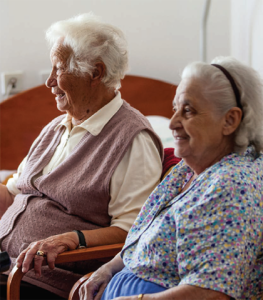Aged care failing diverse communities – Scanlon report
The requirements of culturally diverse people in aged care have been repeatedly sidelined by providers and governments, according to a new report.
The latest ‘narrative’ from the Scanlon Foundation Research Institute, titled ‘Aged Care’s Culture Gap: How to respond to the needs of a diverse and ageing population’, examines how Australia’s aged care system is largely failing people from migrant and diverse backgrounds.
 The report says that while agencies and regulators sometime deliberately ignore the needs of diverse elderly people, more often it is result of a lack of understanding of minority communities and their needs.
The report says that while agencies and regulators sometime deliberately ignore the needs of diverse elderly people, more often it is result of a lack of understanding of minority communities and their needs.
“The need is to build a better connection between people from diverse backgrounds and the aged care system,” say report authors Rick Morton and Trish Prentice.
“The goal for aged care should be to create a system that can respond to Australia’s great and growing diversity. People from migrant backgrounds, and of course even those from the same birth countries, have a constellation of interests and differences,” the report says.
“Across all groups, some people will feel that their culture is the touchstone in their life. Others may see it as a backdrop against which their life has been staged but not the set piece.
“This is the central story of diversity. It is the central policy challenge,” the report says.
It says 170,000 people lived in residential aged care facilities across Australia. More than 30,000 – or almost one in five (18.3 per cent) of residents – were born in a non-English-speaking country.
The proportions varied from 6.9 per cent in Tasmania to 23.9 per cent in Victoria, with the vast majority living in Victoria and NSW.
About 16,000 residents of nursing homes indicated that their preferred language was not English. Some of these were Indigenous people, particularly in the Northern Territory, but most were from migrant communities in NSW and Victoria.
Unsurprisingly, most came from migrant groups who have been in Australia for many years.
The report says that since aged care was privatised under the Howard government in late 1990s a series of [problems have emerged. These include language barriers, putting elderly resident sin care homes far from their familiar communities and too few direct care hours,
The report also cites aged care workforce shortages and overly complex system that often excludes community based organisations.
The report recommends that any revision, amendment or replacement of the Aged Care Act should enshrine a rights-based approach for all consumers of aged care services and especially those from diverse backgrounds.
“This should include the right to timely, well-resourced interpreting services pre-access and throughout a person’s time in care,” the report says.
It says the federal government should introduce a Level 5 home care package funded on par with the average annual cost of a nursing home resident in recognition of the overwhelming preference of Australians to receive care in their own home, closer to their community.
The report also recommends the government unlock a supply of skilled migrants for the booming aged and disability care sectors from a range of different countries and backgrounds.
“But this should only be done where visas or labour agreements have a strong, legislated minimum wage and tough penalties for employers that do not comply. Such a setting would help prevent exploitation of workers and raise the quality of care in the industry,” the report says.
The report recommends that direct care hours be boosted across all levels of aged care staff.
“We recommend going further than the Royal Commission, however, and introducing minimum staff to resident ratios with taxpayer funding tied explicitly to this provision,” the report says.
It says the federal government ought to make entry into the home care sector for community-based organisations simpler and fairer.
“Such a framework should recognise that home support has benefits beyond the physical care itself, such as access to social connection, language and economic dividends for workers from diverse communities,” the report says.
See the full narrative here: Aged Care’s Culture Gap: How to respond to the needs of a diverse and ageing population | Scanlon institute












